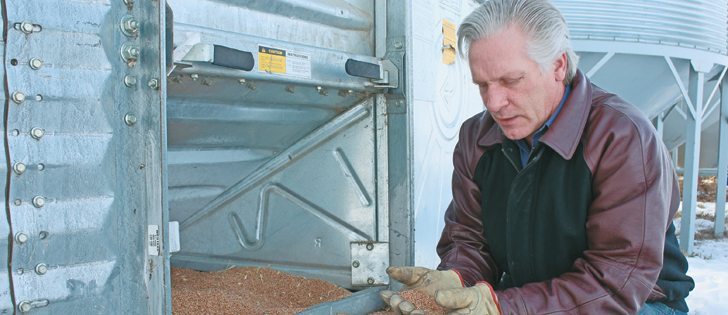Grain transportation problems are turning an oversupplied market into a disaster, slashing grain prices and ballooning the amount of crop carried over into the new year. Unable to deliver, farmers are struggling with cash flow problems. Processors are curtailing operations for lack of raw product and importers that normally buy from Canada are seeking more reliable supplies. Western Producer reporter Brian Cross begins a multi-week transportation special report with a cross section of farmers’ views on what is causing the problem. (to visit part two of the series click here) (part three is available here)(part four is available here) Farming Smarter near Lethbridge got a boost to its research equipment, thanks to the Alberta government’s increase in funding for research associations.
Read Also

Farming Smarter receives financial boost from Alberta government for potato research
Canadian farmers who harvested a record 95 million tonne crop last year are swimming in an ocean of undelivered grain.
Much of it will remain in farm storage to start the next crop year.
The sheer volume of the bin-busting harvest weighs heavily on the Canadian grain industry as grain movement slows to a crawl in the dead of winter.
Some farmers are in decent shape, notably those who contracted grain early and aggressively.
But others are desperately treading water and looking for a lifeline, including those who took a wait-and-see approach to selling their crop.
Still others see an industry that is floundering, unable to stay afloat in a hostile environment where railways have too much power and farmers too little. Many positive aspects of the grain transportation system have been swept out to sea.
“I’m not sure what the right word is to describe the situation this year,” said Randy Hoback, a former farmer who is now a Conservative MP for Prince Albert, Sask.
“Is it disaster? Is it incompetent? A whole bunch of words come to mind, but no matter how you describe it, it looks like CN (Canadian National Railway) and CP (Canadian Pacific Railway) have not kept up with the capacity that’s required to move products from Saskatchewan, Alberta and Manitoba to port,” he said.
“Unfortunately, the people who are going to pay for that are the farmers.”
Hoback, a member of the House of Commons’ standing committee on agriculture, has heard all kinds of grain transportation horror stories.
In northeastern Saskatchewan, a short-line railway that loads producer cars is 200 hopper cars behind in order fulfillment.
In central Saskatchewan, an oat grower has accumulated 80 cars of milling oats that are loaded and ready to be moved to a U.S. miller. The cars have sat in a Saskatoon rail yard for weeks, waiting for the locomotive power and rail capacity to move them.
Meanwhile, American end users who depend on Canadian grain are running their plants at reduced capacity.
Hoback said one U.S. oat miller is 700 hopper cars behind in production.
Another has decided to import oats from northern Europe.
At the West Coast, ships line up waiting for grain.
Pulse Canada and the Western Canadian Grain Elevators Association said last week that 54 grain vessels were waiting at the West Coast to load at Vancouver and Prince Rupert terminals, pushing total vessel demurrage fees over $25 million.
Outstanding grain car orders in Western Canada have reached an unprecedented 51,000 cars, said the WGEA.
Hoback said all factors point to a system that has failed farmers and agricultural shippers.
“Western Canada’s farmers have gone through a process to make an efficient delivery system for the railways,” Hoback said.
“We got rid of our branch lines, we got rid of our small-town elevators, we went to high-throughput terminals and we all went out and bought super-Bs to deliver grain to those terminals.… Farmers gave up a lot to get a more efficient system, but the paybacks didn’t come back to them.”
Glenn Tait of Meota, Sask., is one of those farmers caught in the middle.
He said the railways deserve some of the blame for this year’s transportation problems, but not all of it.
Tait thinks much of the blame resides with the federal government and its decision to eliminate CWB’s single desk.
Tait, a self-professed CWB supporter and a current director of the National Farmers Union, said the wheat board did more than market grain.
It also played an important role in co-ordinating grain movement across the Prairies, negotiating capacity with rail companies and exerting influence over other players in the system.
Tait doesn’t contend that transportation problems were non-existent under single desk marketing. However, he argues that CWB moved prairie wheat to market in a more orderly and equitable fashion, giving all producers an equal opportunity to sell some of their grain.
“This is the biggest crop we’ve ever grown and there would be trouble moving it out,” said Tait, who projects he will carry one-third of last year’s production forward into the new crop year.
“Even with the CWB in place, we might have five or 10 percent left over, but … if we continue the way we’re going right now, we could have between a third to half of our crop left as of Aug. 1.”
Tait said many farmers were cautious marketing last year’s bumper crop.
Perhaps by force of habit or perhaps by necessity, many growers focused first on harvesting and later on selling their grain.
That plan left many in a desperate situation.
He said farmers in the Meota area are looking for any chance to deliver grain.
Elevators at nearby North Battleford are filled to capacity and rail sidings are plugged with hopper cars that were loaded weeks earlier.
Major elevator companies are said to be at least four to six weeks behind schedule in loading cars at country locations and executing sales programs.
Price is another story.
By some accounts, Asian importers are paying more this year for high quality milling wheat than they were a year ago, said Tait.
Meanwhile, Canadian farmers are on the outside looking in, unable to find delivery opportunities or forced to take a significantly discounted price.
“The best thing we could do is bring back the Canadian Wheat Board or some parallel entity,” said Tait.
“It’s possible that the government will (realize) that … we do need some co-ordination in grain movement and will create a federal authority to do so, in the interests of the nation and in the interests of the agriculture industry.
“Unless we have some sort of co-ordination with some type of lawful authority behind it, I don’t see much room for improvement in years.”
Across the border in Alberta, Irma-area grain farmer Kent Erickson is in a better position.
Erickson, a well-spoken advocate of free market economics, contracted much of his 2013 crop before it was harvested.
As of last week, 75 to 80 percent of Erickson’s 2013-14 production had been delivered.
“This year, we were pretty fortunate in that a lot of our grain went right off the combine,” said Erickson, who holds a degree in economics and counts marketing as one of his managerial strengths.
Erickson conceded that there are many factors behind the problems encountered this year.
Insufficient rail capacity is one factor but not the only one.
He said every piece in the supply chain, including producers, grain companies and railways, is learning how the system works and how to cope with the new challenges in addressing the new marketing environment.
Diversified production is a good strategy to reduce risk at the farm level, he added.
Erickson’s rotation included spring wheat, winter wheat, canola, oats, malting barley, flax and peas last year.
Anything growers can do to reduce their dependence on rail capacity and export markets is beneficial.
Growers in Erickson’s area also have access to reliable local markets, including a large livestock feed buyer in Irma and a nearby oat processor at Camrose.
The area is also served by line companies with facilities on both CN and CP tracks, a rare thing in Western Canada.
Growers in other areas are not so fortunate.
Erickson acknowledged that improving market access and supply chain logistics is vital to all farmers, regardless of their individual situations.
He said all farmers will feel the impact if Western Canada carries forward 10 million tonnes of wheat and has an average crop this fall.
“Any way you look at it, the rail companies need to increase efficiency and we need to find ways to make them want to move grain,” he said.
“We’ve got more oil moving by rail, more potash and more lumber.… We need to be putting what needs to be in a pipeline, in a pipeline.”
(to visit part two of the series click here) (part three is available here)(part four is available here)


















